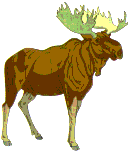Synchronized Birth
One of the many designs seen in nature is the amazing balance between prey
and predator. To keep plant-eating animals from totally cleaning out all
vegetation, there is a need to control their population. To avoid eating
all the plant eaters, there is a need to control predators' numbers. There
is a large number of ways in which this is accomplished. One way that plant-eating
animals avoid over-predation in Alaska is a phenomenon biologists call "synchronized
birth."
 In the Kenai Peninsula, there are about 6,500 moose. The black bear, brown
beer, and wolf population adds up to about 4,000. These predators eat sick
and injured moose year around, but they will also eat baby moose during the
first few days of their lives if they can find them. If the baby moose were
born over a month or two period of time, this predation could make a sizable
dent in the moose population. As it is, all baby moose are born on the same
day--May 25th. Within a day or two, the babies are capable of speed and
mobility and no longer vulnerable to predators. The ultimate result is that
very few baby moose are eaten by predators.
In the Kenai Peninsula, there are about 6,500 moose. The black bear, brown
beer, and wolf population adds up to about 4,000. These predators eat sick
and injured moose year around, but they will also eat baby moose during the
first few days of their lives if they can find them. If the baby moose were
born over a month or two period of time, this predation could make a sizable
dent in the moose population. As it is, all baby moose are born on the same
day--May 25th. Within a day or two, the babies are capable of speed and
mobility and no longer vulnerable to predators. The ultimate result is that
very few baby moose are eaten by predators.
 Caribou use the same process to reduce predation of their young. Maintaining
a balance between food and population is a struggle mankind has not mastered
yet, but God's design is a great and working system that only gets into trouble
when man interferes with it. These systems are highly complex and are minimally
understood by man. Chance is a poor explanation for all of this design.
Complexity of this nature is only possible by intelligence of the highest
order.
Caribou use the same process to reduce predation of their young. Maintaining
a balance between food and population is a struggle mankind has not mastered
yet, but God's design is a great and working system that only gets into trouble
when man interferes with it. These systems are highly complex and are minimally
understood by man. Chance is a poor explanation for all of this design.
Complexity of this nature is only possible by intelligence of the highest
order.
--Reference: Alaska, October 2001, page 13.
Back to Contents Does God Exist?, NovDec03.
 In the Kenai Peninsula, there are about 6,500 moose. The black bear, brown
beer, and wolf population adds up to about 4,000. These predators eat sick
and injured moose year around, but they will also eat baby moose during the
first few days of their lives if they can find them. If the baby moose were
born over a month or two period of time, this predation could make a sizable
dent in the moose population. As it is, all baby moose are born on the same
day--May 25th. Within a day or two, the babies are capable of speed and
mobility and no longer vulnerable to predators. The ultimate result is that
very few baby moose are eaten by predators.
In the Kenai Peninsula, there are about 6,500 moose. The black bear, brown
beer, and wolf population adds up to about 4,000. These predators eat sick
and injured moose year around, but they will also eat baby moose during the
first few days of their lives if they can find them. If the baby moose were
born over a month or two period of time, this predation could make a sizable
dent in the moose population. As it is, all baby moose are born on the same
day--May 25th. Within a day or two, the babies are capable of speed and
mobility and no longer vulnerable to predators. The ultimate result is that
very few baby moose are eaten by predators. Caribou use the same process to reduce predation of their young. Maintaining
a balance between food and population is a struggle mankind has not mastered
yet, but God's design is a great and working system that only gets into trouble
when man interferes with it. These systems are highly complex and are minimally
understood by man. Chance is a poor explanation for all of this design.
Complexity of this nature is only possible by intelligence of the highest
order.
Caribou use the same process to reduce predation of their young. Maintaining
a balance between food and population is a struggle mankind has not mastered
yet, but God's design is a great and working system that only gets into trouble
when man interferes with it. These systems are highly complex and are minimally
understood by man. Chance is a poor explanation for all of this design.
Complexity of this nature is only possible by intelligence of the highest
order.